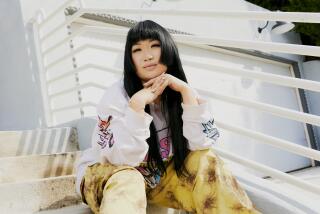A Tight Pair: Man and His Jeans
- Share via
It’s hard to separate a man and his blue jeans.
Guys become attached to jeans the way they might to a car or favorite baseball team. Whether loyal to their Levi’s or hooked on designer jeans such as Calvin Klein and Versace, men who otherwise could not care less about fashion have definite opinions on jeans.
Some like them tight; some like them loose.
Some won’t spend more than $20 on a pair; others fork out $200 for the privilege of displaying a status label on their backsides.
Men hate to part with an old pair of jeans. They treasure their jeans’ worn places and faded blue. Years of wear will transform a man’s jeans into a frayed and faded garment as individual as his thumbprint.
Perhaps no other jeans incite more devotion in a man than Levi’s 501s.
Locals Only, a vintage clothing store in Laguna Beach, sells only pre-worn Levi’s 501s (see story on page 4). The fascination with Levi’s stems from their history, says Larry Craig, owner of Locals Only.
“There’s a whole Levi mystique of the Wild West. They’re very masculine, and they’re American-made,” Craig says. “People identify with them.”
Such devotion would amaze Levi Strauss, a Bavarian immigrant who arrived in San Francisco in 1853 during the height of the gold rush and found his fortune in jeans.
Strauss was operating a dry goods store when he hit upon the idea of making sturdy pants for miners in the 1870s. Before long he’d run out of the heavyweight brown canvas he’d imported from Bavaria and began making his pants out of denim, so named because the fabric came from Nimes, France, and was called serge de Nimes, later shortened to just denim.
(The word jeans comes from the twilled cotton cloth, similar to denim, used to make work pants in Genoa, Italy. Genoa was shortened to genes, and became jeans when translated into English.)
It wasn’t long before Levi’s became popular with cowboys--who would sit in horse troughs filled with water to get the pants to shrink.
To add to the Levi’s lore, Levi Strauss & Co. recently held a contest to find the oldest pair of blue jeans in the United States. The winner, Heath Rackley of Lubbock, Tex., found a pair at the bottom of a Nevada silver mine that date to the 1920s.
Jeans have since evolved into a high-fashion item, with Calvin Klein, Gianni Versace and just about every major designer delving into denim.
Versace’s line of couture jeans is hot with young, fashion-forward men, says William Kennedy, sales representative for Bernini Sport in South Coast Plaza, Costa Mesa.
“They’re buying a certain aura with those jeans,” Kennedy says. That certain aura comes with a price: about $200 a pair.
The line ranges from a basic indigo or solid black denim jeans with Versace’s trademark leather patch and gold Medusa head on the back ($195) to a wild pair printed all over with colorful crosses ($225). One navy pair has rainbow-hued thread used for the double top-stitching ($185).
Though jeans were once considered working pants, they’re now worn everywhere with practically anything, Kennedy says.
“Men come in here and buy $1,200 cashmere sport coats, and they’re going to wear them with jeans,” he says.
Some fashion rebels still wear jeans two or three sizes too large, but most men want jeans with a narrow yet comfortable fit, says Elie Kevorkian, menswear buyer for Politix in Fashion Island Newport Beach. Among Politix’s best-selling brands: Diesel, Rivet, Big Star and Fire Trap ($60 to $145). The jeans come dyed in the season’s neutral hues such as stone, brown, hunter green and beige, but nothing beats a faded indigo.
“Men like their jeans to look worn,” Kevorkian says.
Trendy colors and designer names don’t matter to at least one segment of the jeans-wearing population.
“My customer is the true jeans customer. He’s very resistant to change,” says Alexa Garrell, vice president and menswear buyer for the Grant Boys in Costa Mesa.
“Most of the older guys are die-hards,” she says. “We have guys come in and buy the same jeans they wore in high school. If they wore boot-cut jeans, they want boot-cut.” Wranglers and Levis are top sellers at the Grant Boys, and they go for $20 to $30 a pair.
Like the gold miners before them, many guys want jeans just for work. Dino Katsiametis, owner of Denim Blue in Garden Grove and Anaheim, says, “Levi’s are working pants and always have been.”
Whether chosen for function or fashion, jeans have become a staple of most men’s wardrobes.
“Jeans are like a uniform,” Craig says. “They always look good on guys, and every guy has three or four pairs in various degrees of fading.”






